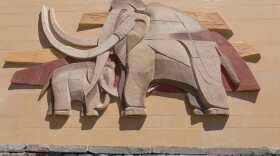The first phase of the Cleveland Museum of Natural History’s $150 million centennial makeover is wrapping up with the opening this weekend of the new Ralph Perkins II Wildlife Center and Woods Garden.
The two-acre exhibit features around 100 native Ohio animals in a setting that allows them to explore a series of overhead trail ways.
WKSU’s Jeff St.Clair takes us on a tour.
Our guide is director of wildlife resources Harvey Webster. He says the New York-based designers solved the challenge of siting a facility on the side of a gully by building an elegant, elevated walkway for visitors.

The path turns back to the hillside and winds its way along the slope in a graceful curve two stories above a trio of coyotes below.
“When you turn back,” says Webster, “the exhibits open like an amphitheater built into the hillside.”
The coyotes are orphans from Texas. Webster explains that a wildlife biologist had struck and killed a pregnant coyote one night north of Dallas and performed a roadside cesarean on the animal to deliver four pups. They survived, and were hand raised but became too tame to return to the wild. Three of them were eventually adopted by the museum in Cleveland.
The coyotes have 6,500 square feet of space to roam - including a ramp leading to an aerial trail way that leads to a spiral staircase down to a separate paddock on the other side of the garden.

It’s not just the coyotes who have access to extra-curricular explorations. Webster points to a smaller tunnel attached to the raccoon’s pen. The animal walkway is made of aluminum hoops surrounded by stretched stainless steel mesh that creates a sturdy, lightweight tube for critter traffic.
Webster says the notion behind these aerial trail ways is that no matter how naturalistic you make any enclosure, it’s still a box. “This gives the animal the opportunity to leave the box,” he says.
Scarlet, one of the red foxes enjoys a snooze on an elevated platform. It’s part of a staggered series of perches connected by wooden ramps. These in-turn lead to another aerial trail way, slightly bigger than the raccoon’s, that the fox shares with its neighbors, the gray foxes and a pair of bobcats.
On alternate days keepers will open a door onto the 250 foot long elevated tunnel and allow the foxes to roam the neighborhood and inspect the other inhabitants’ dwellings.
The trail way system is inspired by pioneering work at the Philadelphia Zoo. The wildlife garden in Cleveland is one of only a handful of facilities to experiment with the trail ways in the hopes that it adds enrichment to the lives of the animals and the human visitors.

Webster says people are already asking what might happen if the animal decides to do its "business" while crossing overhead. The answer, he says, is, “we don’t know. It’ll probably come down, and maybe we’ll start an umbrella franchise.” But Webster says not to worry. In the decade that a much larger aerial trail way system has been in place in Philadelphia they haven’t seen much of a problem with waste raining down. The animals, apparently have better things to do than torment humans in that way.
The new Ralph Perkins II Wildlife Center and Woods Garden also features dozens of native bird species, including song birds, ducks, raptors, owls, and even a graceful pair of sand hill cranes.
One of the main attractions is a Plexiglas pool where a pair of otters cavort and play in endless cycles of tag.
Coming soon are native fishes, turtles and amphibians in a pond habitat sliced in cross-section for viewing.
Webster says the wildlife garden is a trailhead for visitors to get to know their wild neighbors close up and hopefully foster interest in helping preserve natural habitats for the species that share our corner of Ohio.
The new Cleveland Museum of Natural History wildlife garden opens to the public Friday night at 5:30 and is open 10am–5pm Saturday, Sunday, and on Labor Day.












